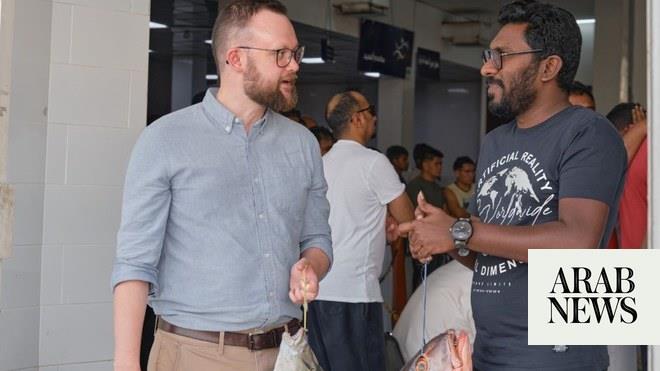
Some 100 pieces of furniture and textiles have been recreated based on traditional Saudi techniques
Items have formed backdrop to high-profile meetings with dignitaries such as John Kerry
RIYADH: When Saudi Arabia’s Crown Prince Mohammed bin Salman met with US Special Presidential Envoy for Climate John Kerry on June 16, there was something about the official photos that caught the eye.
Instead of the usual understated grandeur of a palace interior where such senior officials would usually meet, Kerry found himself surrounded by a splendid display of traditional Najdi decor.
Giant strings of bedouin beads hung on the walls above him and stunning hardwood tables, surrounded with colorful poufs, adorned the floor space.
Arab News can reveal that the interior design is part of a project requested by the crown prince to create more than 100 unique items that represent the heritage of Najd.
Cyma Azyz and Faisal Al-Saadaway were tasked with having the textiles, furniture and other items handcrafted using entirely Saudi tools and materials.
Saudi Crown Prince Mohammed bin Salman (C) meeting with the US Special Presidential Envoy for Climate John Kerry (2nd-L) in the capital Riyadh in June. (AFP/Saudi Royal Palace/File Photo)
Azyz told Arab News that the crown prince requested that not a single nail from outside the Kingdom be used on the project.
Al-Saadaway is one of the most experienced collectors of Saudi antiquities in Riyadh and has expertise in the architecture and design of Najd, Saudi Arabia’s vast central region, while Azyz was a television anchor with a passion for the preservation of Najdi arts and culture.
The two were first approached for the private project in their outlet in Diriyah — called “Saadaway Najd” — by an interior designer for the crown prince.
The designer was intrigued by their collection and visited their main Arts and Antiques Gallery in Olaya in the summer of 2018.
“The gentleman paid us a visit and was astonished at the eclectic quality of antiques and delighted to see our large selection of Najdi furniture, accessories, and textiles that were inspired by the Bedouin rugs for upholstery and curtains,” Azyz said.
From there, the construction began. The crown prince’s team wanted to ensure that traditional Najdi craftsmanship and design were represented in every piece of the project.
The most prominent part of the project became known as the “Majlis,” where political leaders and guests like John Kerry meet the crown prince.
Cyma Azyz and Faisal Al-Saadaway were tasked with having the textiles, furniture and other items handcrafted using entirely Saudi tools and materials. (AN Photo/Lama Al-Hamawi)
The team first researched the authentic Najdi techniques of construction and furnishing that were available through the assistance of local sources and the government.
They then visited traditional village homes to study the detailing and design of the furniture.
“The sheer quantity of the details and design in the data collection allowed us to create authentic designs efficiently, which is the reason behind the fast completion of the crown prince’s project,” Azyz said.
“A project of this magnitude realistically cannot be completed in less than one year, but the timeline given was three months,” she said.
The project included vintage leather water pouches, painted leather panels, armchairs, sofas, coffee tables, study tables, sideboards, chests, chairs, alabaster vases and more.
The partners spent day and night crafting each piece to perfectly represent Saudi culture.
There were numerous techniques used in the project including the detailing and hand carving of the side tables, the painting of the gold and copper nails, and the etching, burning and engraving of each piece.
The design of the project was established within the Olaya gallery, but the production of each piece was carried out in a workshop in Saniyah, Riyadh’s industrial area.
Instead of the usual understated grandeur of a palace interior where such senior officials would usually meet, John Kerry found himself surrounded by a splendid display of traditional Najdi decor while meeting with Crown Prince Mohammed bin Salman. (AN Photo/Lama Al-Hamawi)
“I personally oversaw the production of the pieces, from the early hours of the morning to past midnight, in a workshop in Saniyah,” Azyz said.
She was the only woman in the workshop, and her brothers would complete their workday in a bank and help her with the project.
“It is not an area where women are commonly seen, but this project, having such limited time constraints and so many details, called on us to join forces with our factory workers and carpenters.”
The delivery process was also very intricate because there were so many fragile pieces that took hours to create.
“The classic Najdi furniture doesn’t come with loose screws and washers to be boxed and sent. Actually, it cannot be easily assembled on-site, so we had to send finished pieces, meaning larger truckloads,” Azyz said.
Azyz and Al-Saadaway said they were passionate to take on the project because of its importance in preserving the local heritage.
“In this era of modernization, it is very important to keep the heritage and culture alive for younger generations to learn about their past and history,” Azyz stated.
“I have personally met and worked with craftsmen from different parts of the Kingdom and was devastated to learn that most of them do not care about passing their handicrafts onto their children, as they want them to pursue brighter career prospects following education in big institutes and life in bigger cities,” Azyz said.
“Our crown prince is not only living by example but has taken it one step further with mega projects that are heralding the era of ‘made in Saudi Arabia’ for the revival and preservation of our folk arts.”











